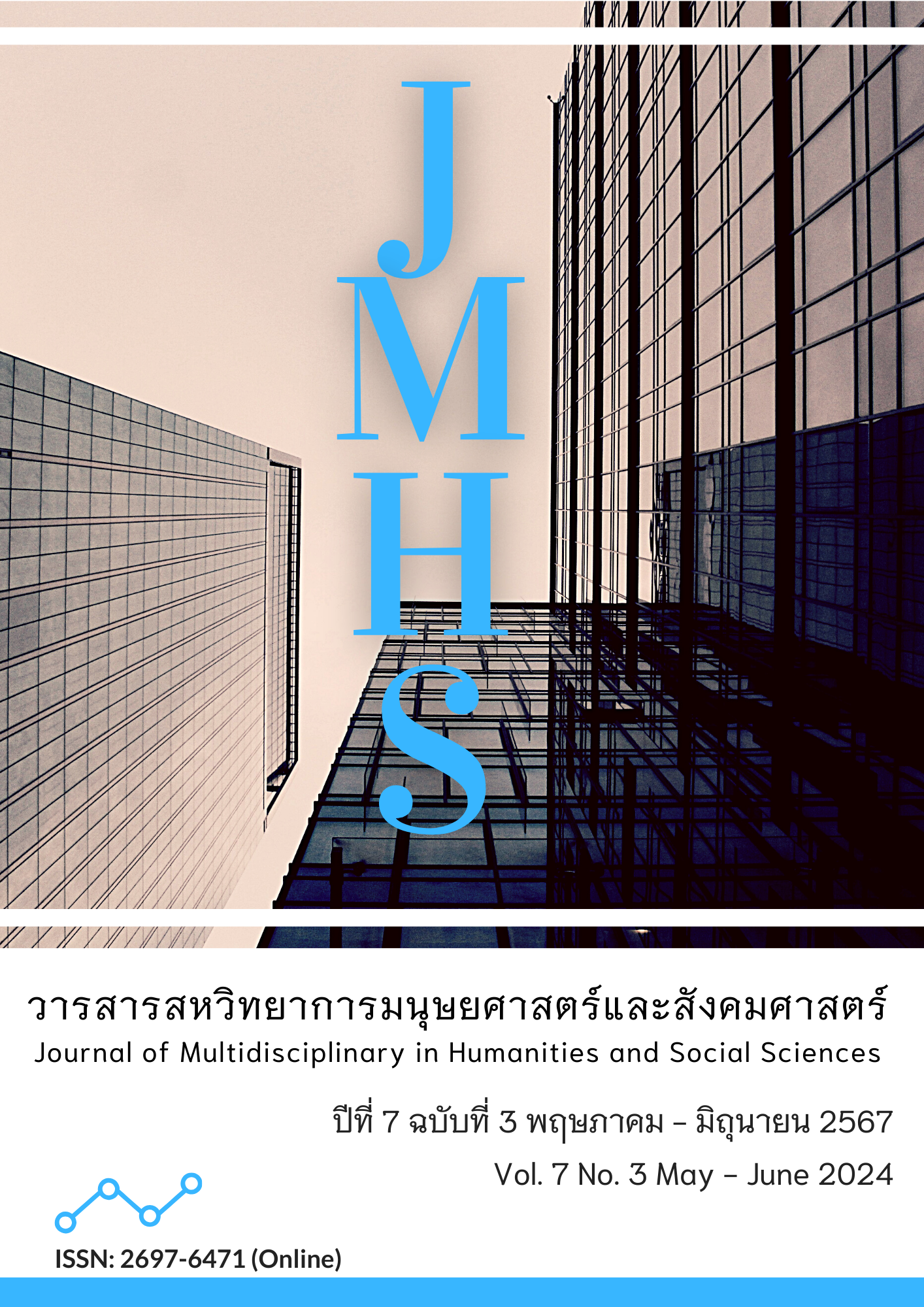Causal Factors Influencing Purchasecing Decisions Bakery via Instagram in Bangkok and Its Vicinity
Main Article Content
Abstract
The article aimed to: 1) develop and validate a causal relationship model for purchasing decision bakery via Instagram in Bangkok and its vicinity; and 2) study causal factors influencing purchasing decision bakery via Instagram in Bangkok and its vicinity. This study was quantitative research. The sample was people who have bought bakery via Instagram and live in Bangkok and its vicinity of 385 people by convenience sampling. The tools used in the research were online questionnaires. The statistics used in data analysis were frequency, percentage, confirmatory factor analysis, and structural equation model.
The results of this research were the development of the causal relationship models, which consisted of four components: 1) awareness; 2) loyalty; 3) repurchase intention; and 4) purchase decision. The model was consistent with the empirical data to a great extent. The statistics showed CMIN/df = 2.21, GFI = 0.96, AGFI = 0.92, SRMR = 0.02, and RMSEA = 0.06. The final predictive coefficient was 0.62, indicating that the variables in the model can explain the variance of the purchase decision to buy a bakery via Instagram by 62 percent. It was found that awareness, loyalty, and repurchase intention were respectively influential on purchase decisions. Bakery’s entrepreneur via Instagram is able to use the research’s results to plan strategies that are appropriate for consumers and make their business successful and sustainable.
Article Details

This work is licensed under a Creative Commons Attribution-NonCommercial-NoDerivatives 4.0 International License.
Views and opinions appearing in the Journal it is the responsibility of the author of the article, and does not constitute the view and responsibility of the editorial team.
References
กระทรวงดิจิทัลเพื่อเศรษฐกิจและสังคม. (2566, 21 มีนาคม). แผนปฏิบัติราชการสำนักงานปลัดกระทรวงดิจิทัลเพื่อเศรษฐกิจและสังคม ระยะ 5 ปี พ.ศ. 2566 – 2570 (ฉบับปรับปรุงประจำปีงบประมาณ พ.ศ. 2567). สืบค้นเมื่อ 20 มีนาคม 2567, จาก https://www.mdes.go.th/law/download/6691
กรัณย์พัฒน์ อิ่มประเสริฐ. (2565). การใช้เครื่องมือการตลาดดิจิทัลเพื่อให้ผู้บริโภคตัดสินใจซื้อสินค้าง่ายขึ้น. วารสารบริหารธุรกิจ มหาวิทยาลัยราชพฤกษ์, 1(1), 1-15. สืบค้นจาก https://so03.tci-thaijo.org/index.php/RPUBAJOURNAL/article/view/261820
กรุงเทพธุรกิจ. (2565, 27 กรกฎาคม). ตลาดออนไลน์ยังไม่คลายมนต์ขลังแม้ในวันเศรษฐกิจอ่อนแรง. สืบค้นเมื่อ 20 มีนาคม 2567, จาก https://www.bangkokbiznews.com/blogs/business/1080526
ฉันธะ จันทะเสนา. (2562). การวิเคราะห์อิทธิพลความภักดีและการตระหนักในตราสินค้าที่มีต่อการตัดสินใจซื้อรถจักรยานยนต์โดยวิธีกำลังสองน้อยที่สุดบางส่วนแบบคงเส้นคงวา. Veridian E-Journal, Silpakorn University (Humanities, Social Sciences and Arts), 12(6), 1883-1904. สืบค้นจาก https://he02.tci-thaijo.org/index.php/Veridian-E-Journal/article/view/193218
ชมพู บุญยิ่งยง. (2564, 2 กรกฎาคม). ผู้บริหารบอกเอง จากนี้ไป Instagram คือ “แพลตฟอร์มวิดีโอ” ไม่ใช่แอปฯ ที่เอาไว้ อวดแค่รูปภาพอีกแล้ว. สืบค้นเมื่อ 20 มีนาคม 2567, จาก https://thestandard.co/instagram-social-media-app/
ชาญชัย ชัยประสิทธิ์. (2565, 23 กรกฎาคม). พฤติกรรมผู้บริโภคกับความคาดหวังต่อธุรกิจที่เปลี่ยนไปในยุคหลังโควิด. สืบค้นเมื่อ 20 มีนาคม 2567, จาก https://www.pwc.com/th/en/pwc-thailand-blogs/blog-20220725.html
ณัฐพงศ์ เจริญดีทรัพย์สิริ, ศิริรัตน์ โกศการิกา และ ยุพาวรรณ วรรณวาณิชย์. (2564). การสื่อสารทางการตลาดผ่านสื่อสังคมออนไลน์ที่ส่งผลต่อการรับรู้ตราสินค้าและส่งผลต่อกระบวนการตัดสินใจซื้อเสื้อผ้าออนไลน์. วารสารเกษตรศาสตร์ธุรกิจประยุกต์, 15(23), 21-40. สืบค้นจาก https://so04.tci-thaijo.org/index.php/KAB/article/view/250078
เดชา พละเลิศ, ธาตรี จันทรโคลิกา, กอบกูล จันทรโคลิกา, พาสน์ ทีฑทรัพย์, ศุภวัฒน์ สุขะปรเมษฐ และ เกษรา กาญจนภูมิ. (2564). ปัจจัยที่ส่งผลต่อความผูกพันกับแบรนด์ของผู้บริโภคและความภักดีต่อแบรนด์ในชุมชน แบรนด์เสมือนจริงบนโซเชียลมีเดียของผู้บริโภคที่ใช้รถกระบะ ในเขตกรุงเทพมหานครและปริมณฑล. วารสารการจัดการธุรกิจมหาวิทยาลัยบูรพา, 11(1), 67-87. สืบค้นจาก https://so01.tci-thaijo.org/index.php/BJBM/article/view/249476
ธัญญ์นภัส ภูวนันท์ทวีสิน, เพชรรัตน์ วิริยะสืบพงศ์ และ สานนท์ อนันทานนท์. (2565). ปัจจัยทางด้านตราสินค้าที่มีอิทธิพลต่อการซื้อซ้ำ โดยการวิเคราะห์ห่วงโซ่คุณค่าผลิตภัณฑ์ผลไม้แปรรูปในภาคตะวันออก: กรณีศึกษาทุเรียน. วารสารวิชาการ มหาวิทยาลัยกรุงเทพธนบุรี, 11(2), 1-15. สืบค้นจาก https://so01.tci-thaijo.org/index.php/bkkthon/article/view/257963
ธีรนาฏ ขาวละออง และ สมบัติ ธํารงสินถาวร. (2564). ปัจจัยทางด้านการตลาดที่ส่งผลต่อความภักดีของผู้บริโภคต่อร้านอาหารเชิงท่องเที่ยวในจังหวัดชลบุรี : บทบาทของความชื่นชอบความ หลากหลายของผู้บริโภค. วารสารรัชต์ภาคย์, 15(42), 354-367. สืบค้นจาก https://so05.tci-thaijo.org/index.php/RJPJ/article/view/252451
โมทิฟว อินฟลูเอนเซอร์. (2566, 1 มิถุนายน). สถิติ + เทรนด์ Influencer Marketing บน Instagram ปี 2023. สืบค้นเมื่อ 20 มีนาคม 2567, จาก https://www.motiveinfluence.com/blog/marketing/สถิติ--เทรนด์-Influencer-Marketing-บน-Instagram-ปี-2023/573
รุ่งโรจน์ สงสระบุญ. (2562). ปัจจัยทางการตลาดที่มีอิทธิพลต่อการตัดสินใจซื้อคอนโดมิเนียมในกรุงเทพมหานคร. วารสารบริหารธุรกิจศรีนครินทรวิโรฒ, 10(1), 80-90. สืบค้นจาก https://ejournals.swu.ac.th/index.php/MBASBJ/article/view/11804
ลลิตา พ่วงมหา. (2563). ปัจจัยเชิงสาเหตุที่มีอิทธิพลต่อความภักดีในตราสินค้าร้านหนังสือ. วารสารมนุษยศาสตร์และสังคมศาสตร์, 26(3), 77-87. สืบค้นจาก
https://so05.tci-thaijo.org/index.php/tgt/article/view/246567
ศูนย์อัจฉริยะเพื่ออุตสาหกรรมอาหาร. (2566, มีนาคม). ส่วนแบ่งตลาดผลิตภัณฑ์ขนมอบ ปี 2565. สืบค้นเมื่อ 20 มีนาคม 2567, จาก https://fic.nfi.or.th/market-intelligence-market-share-detail.php?smid=382
สิริกร เสือเหลือง และ สุรสิทธิ์ อุดมธนวงศ์. (2563). อิทธิพลของบุคคลที่มีชื่อเสียงและการรับรู้โฆษณาแฝงผ่านการตระหนักรู้ตราสินค้า ที่ส่งผลต่อความตั้งใจซื้อรถจักรยานยนต์ของผู้ชมซีรีส์ออนไลน์ในเขตกรุงเทพมหานคร. วารสารวิจัยวิทยาการจัดการ มหาวิทยาลัยราชภัฏสุรินทร์, 4(2), 67-80. สืบค้นจาก https://so02.tci-thaijo.org/index.php/jmsr/article/view/jmsr4-2-006
อริยะ สมบุญ และ สมชาย เล็กเจริญ. (2566). ปัจจัยเชิงสาเหตุที่มีอิทธิพลต่อการบอกต่อแบบปากต่อปากในการซื้อเครื่องสําอางบนแอปพลิเคชันลาซาดาในกรุงเทพมหานครและปริมณฑล. วารสารสหวิทยาการมนุษย์ศาสตร์และสังคมศาสตร์, 6(4), 1746-1763. สืบค้นจาก https://so04.tci-thaijo.org/index.php/jmhs1_s/article/view/264427
เอ็มเคยูนิกรุ๊ป คอร์ปอเรชั่น. (2565, 3 สิงหาคม). ประเภทต่าง ๆ ของเบเกอรี่มีอะไรบ้างนะ. สืบค้นเมื่อ 20 มีนาคม 2567, จาก https://www.mkunigroup.com/blog_mkunigroup.php?id=181
Ali, H. (2019). Building Repurchase Intention and Purchase Decision: Brand Awareness and Brand Loyalty Analysis (Case Study Private Label Product in Alfamidi Tangerang). Saudi Journal of Humanities and Social Sciences, 4(9), 623-634. https://doi.org/10.36348/SJHSS.2019.v04i09.009
Hair, J., Hult, T., Ringle, C., & Sarstedt, M. (2014). A Primer on Partial Least Squares Structural Equation Modeling (PLS-SEM). Thousand Oaks, CA: Sage Publications.
Hair, J.F., Black, W.C., Babin, B.J., & Anderson, R.E. (2010). Multivariate data analysis. (7th ed.). Upper Saddle River, NJ: Prentice Hall.
Hoelter, J. W. (1983). The effects of role evaluation and commitment on identity salience. Social Psychology Quarterly, 46(2), 140–147. https://doi.org/10.2307/3033850
Hu, L.T., & Bentler, P. M. (1999). Cutoff criteria for fit indexes in covariance structure analysis: Conventional criteria versus new alternatives. Structural Equation Modeling, 6(1), 1–55. https://doi.org/10.1080/10705519909540118
Joreskog, K. G., & Sorbom, D. (1984). Advances in factor analysis and structural equation models. Lanham: Rowman & Littlefield Publishers.
Kline, R. B. (2011). Principles and practices of structural equation modeling. (3rd ed.). New York: The Guilford Press.
Schreiber, J. B., Stage, F. K., King, J., Nora, A., & Barlow, E. A. (2006). Reporting structural equation modeling and confirmatory factor analysis results: a review. The Journal of Educational Research, 99(6), 323–337. https://doi.org/10.3200/JOER.99.6.323-338
Schumacker, R. E., & Lomax, R. G. (2004). A beginner's guide to structural equation modeling. (2nd ed.). Lawrence Erlbaum Associates Publishers.
Schumacker, R. E., & Lomax, R. G. (2010). A beginner’s guide to structural equation modeling. (3rd ed.). Routledge /Taylor & Francis Group.
Senayah, W. K., Metsiwodzi, H., Biney-Aidoo, V., Anyanful, T. K., & Opuni, F. F. (2023). An Assessment of Brand Loyalty, Perceived Quality and Price as Antecedents of Purchase Decision: Evidence from Ghana’s Textile Industry. African Journal of Applied Research, 9(1), 174-193. http://doi.org/10.26437/ajar.31.03.2023.11
Sintiya, M. A., Aziz, N., & Praharjo, A. (2023). The influence of Electronic Word of Mouth (e-WOM) and brand awareness on purchase decision. Jurnal Manajemen Bisnis dan Kewirausahaan, 3(2), 111-119. https://doi.org/10.22219/jamanika.v3i02.27361
Thompson, B. (2004). Exploratory and confirmatory factor analysis: Understanding concepts and applications. American Psychological Association. https://doi.org/10.1037/10694-000
Ullman, M. T. (2001). The declarative/procedural model of lexicon and grammar. Journal of Psycholinguistic Research, 30(1), 37–69. https://doi.org/10.1023/A:1005204207369


